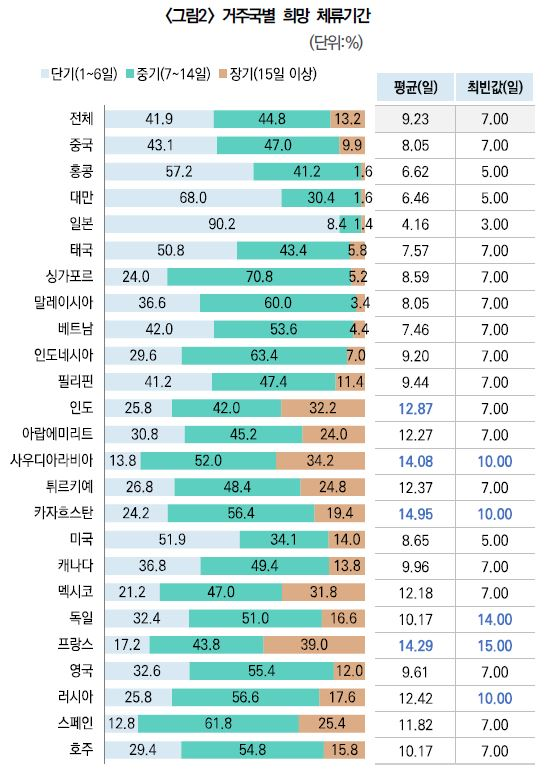

登錄


登錄
海擇短評 Haize Comment:
根據韓國旅遊發展局(Korea Tourism Organization)近期數據,雖然2023年上半年赴韓外國遊客人數(443萬人次)僅較2019年同期恢復53%,遠低於世界旅遊組織(UNWTO)對今年全球國際遊客數量的恢復預期(2019年同期的80-95%),也低於鄰國日本的復甦程度。但若從外國遊客赴韓的平均停留時間與消費行為來看,已與2019年同期有若干不同,值得旅行社與投資機構參考。
2019年,外國遊客赴韓平均停留時間為6.7天,2023Q2增加了1.4天,達8.1天;近期停留時間則更長,達9.2天。從國籍來看,停留時間與旅行距離相關,與韓國鄰近的東北亞國家,如日本、台灣、香港、中國等,希望短期停留(1-6天)的人數比例較高,平均約在4天左右;對於新加坡、馬來西亞、越南、印尼等東南亞地區的居民來說,希望中期停留(7-14天)的居民比例較高;而長距離國家居民的停留時間則相對多元,美國、西班牙、俄羅斯和英國的短期停留比例較高,沙烏地阿拉伯、墨西哥和法國的長期停留(15天以上)比例較高。
停留時間對消費行為有較大的影響,大致如下:
1. 短期停留的旅客喜歡的活動與規畫較為分散多元;中期停留旅客對自然風光、美食餐廳等旅遊活動興趣濃厚;而長期停留者則偏好醫療旅遊、戶外活動、韓流內容、明星相關文化體驗等各種差異化體驗。
2. 前往首爾以外城市的旅遊需求也因停留時間長短而呈現差異。只去首爾的旅客,依照短期停留、中期停留、長期停留分類,比例分別為37.6%、27.2%、30.2%;較特別的是,部分長期居留者反而認為在首爾就可以完成所有的旅遊需求。除首爾外,熱門城市共同為釜山、濟州、仁川和大邱。
3. 從支出面看,短期停留者的平均每日支出最高,為423美元,是中期停留者267.7美元和長期停留者170.4美元的1.6倍和2.5倍。對於長期居留的人來說,包括機票和住宿費在內的總支出最高,單次旅行達3,481美元。
海擇資本發現,隨著旅遊停留日數增加,韓國的當地玩樂產業也漸趨多元,旅遊目的地城市也逐步擴張,這是與2019年相比最大的轉變。
----------
According to the Korea Tourism Organization, the number of foreign tourists visiting South Korea in the first half of 2023 (4.43 million) only recovered to 53% of the same period in 2019, which is far below the World Tourism Organization (UNWTO)'s recovery projection for global tourist numbers this year (80-95% of the same period in 2019) and also lower than the recovery level of neighboring country Japan. However, if we look at the average length of stay and spending behavior of foreign tourists in South Korea, there are some differences compared to the same period in 2019, which are worth noting for travel agencies and investment institutions.
In 2019, foreign tourists spent 6.7 days on average in South Korea, it has increased by 1.4 days in Q2 2023, reaching 8.1 days; and the stay period has been even longer recently, at 9.2 days. In terms of source countries, the stay length is related to the travel distance: Tourists from neighboring Northeast Asian countries, such as Japan, Taiwan, Hong Kong, and China, tend to prefer short stays (1-6 days), with an average of around 4 days; For residents of Southeast Asian regions like Singapore, Malaysia, Vietnam, and Indonesia, a higher proportion prefers medium-term stays (7-14 days); while residents of long-distance countries show more diverse stay durations. The United States, Spain, Russia, and the United Kingdom have a higher proportion of short-term stays, whereas countries like Saudi Arabia, Mexico, and France have a higher proportion of long-term stays (15 days or more).
The length of stay has a significant impact on consumer behavior, which can be summarized as follows:
1. Short-term visitors prefer activities and plans that are more diverse and scattered; medium-term visitors have a strong interest in natural scenery, gourmet restaurants, and other travel activities; whereas long-term visitors tend to favor medical tourism, outdoor activities, K-pop (Hallyu) content, and various differentiated experiences related to celebrities and cultural experiences.
2. The travel demand to cities other than Seoul also varies with the stay period. Among visitors who only go to Seoul, the proportions of short-term, medium-term, and long-term stays are 37.6%, 27.2%, and 30.2% respectively. Interestingly, some long-term residents believe that all their travel needs can be met just in Seoul. Apart from Seoul, the popular cities include Busan, Jeju, Incheon, and Daegu.
3. In terms of travel spending, short-term visitors have the highest average daily expenditure at $423, which is 1.6 and 2.5 times higher than that of medium-term ($267.7) and long-term visitors ($170.4) respectively. For long-term visitors, the total expenditure including airfare and accommodation is the highest, reaching $3,481 per trip.
Haize Capital noted that as the number of travel days increases, South Korea’s local activity industry becomes more diverse, and the tourist destination cities are gradually expanding. This is the biggest change compared to 2019.
----------
한국관광공사에 따르면 올해 상반기 방한 외래관광객은 443만명으로 2019년 상반기 대비 약 53% 회복했다. 세계관광기구(UNWTO)의 올해 전 세계 관광객 수 회복 전망(2019년 같은 기간의 80∼95%)보다 크게 낮았고, 이웃 일본보다도 회복 수준을 밑돌았다. 그러나 방한 외래객의 한국 평균 체류 기간과 소비 행태를 살펴보면 2019년 같은 기간에 비해 다소 차이가 있어 여행사와 투자기관의 주의가 필요하다.
올해 2분기 방한 외래객의 평균 체류일은 8.1일로 2019년 6.7일 대비 1.4일 늘어났다. 코로나 이후 평균 희망 체류일은 9.2일로 더 길었다. 객원국을 보면 체류 기간은 한국과의 지리적 거리와 관련이 있다. 일본, 중국, 타이완, 홍콩 등 한국과 인접한 동북아 국가와 지역는 상대적으로 단기 체류(1~6일)를 선호하며 평균 체류 기간은 4일 정도다. 싱가포르, 말레이시아, 베트남, 인도네시아 등 동남아 거주자의 경우 상대적으로 중기 체류(7~14일) 희망 비중이 높았다. 반면 장거리 국가 거주자는 더 다양한 체류 기간을 보였다. 미국, 스페인, 러시아, 영국 등은 단기 체류 비율이 높은 반면 사우디아라비아, 멕시코, 프랑스 등은 장기 체류(15일 이상) 희망 비율이 높았다.
체류 기간의 길이는 소비자의 행동에 현저한 영향을 미치며, 다음과 같은 몇 가지로 요약할 수 있다.
1. 단기 체류하는 관광객은 더 다양하고 분산된 활동과 계획을 선호한다. 중기 체류 희망자는 자연 풍경, 맛집 탐방 등 일반적인 여행활동에 관심이 높았던 반면 장기 체류 희망자는 아웃도어 활동과 한류 콘텐츠‧스타 관련 문화 체험, 의료관광 등 다양한 차별화된 경험을 선호했다.
2. 서울 이외의 도시여행을 원하는 수요도 체류기간에 따라 차이를 나타냈다. 서울만 방문하겠다는 희망자 중 단기·중기·장기 체류 비율은 각각 37.6%, 27.2%, 30.2%였다. 흥미롭게도 일부 장기 체류 희망자는 그들의 모든 여행 수요가 서울에서 충족될 수 있다고 생각한다. 서울을 제외한 인기도시는 공통으로 부산, 제주, 인천, 대구 순이었다.
3. 1일 평균 예상 지출 경비는 단기 체류 희망자가 423달러으로 가장 많았다. 이는 중기 체류 희망자 267.7달러, 장기 체류 희망자는 170.4달러 대비 각각 1.6배, 2.5배 높았다. 항공료, 숙박 요금 등이 포함된 총지출 금액은 장기 체류 희망자가 3,481달러로 가장 높았다.
하이저 캐피털은 관광 체류일이 증가함에 따라 한국의 지방 활동 산업이 더욱 다양해지고 여행지 도시도 점차 확대되고 있다고 보고 있다. 이는 2019년과 비교해 가장 큰 변화다.

文章鏈接 Hyperlink:https://www.traveltimes.co.kr/news/articleView.html?idxno=406491
資料來源 Resource:Traveltimes
標籤 Label: Korea Inbound Tour Local Activity Post-pandemic